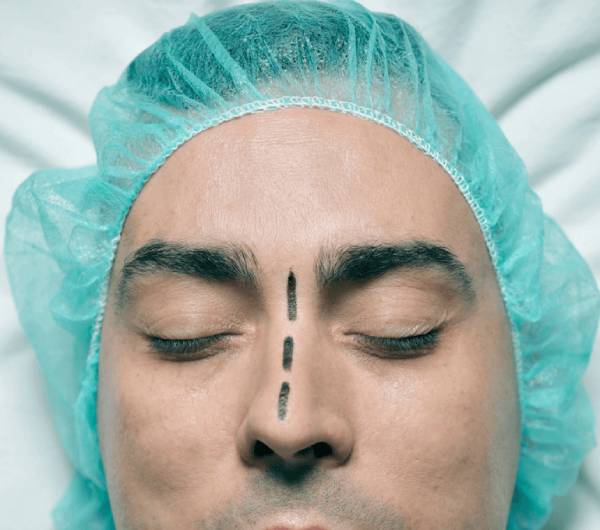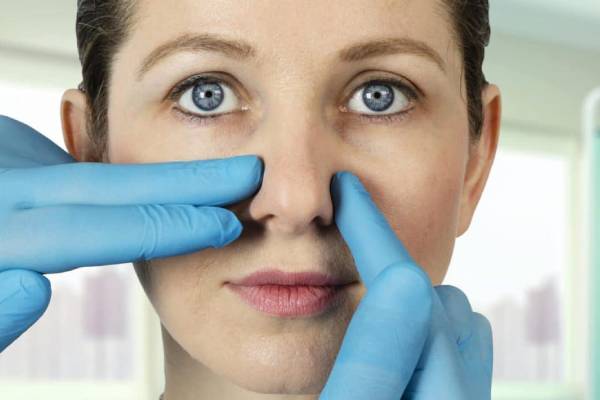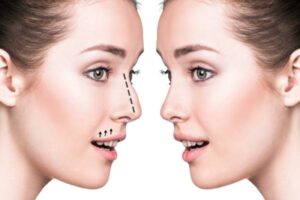Table of Contents
Damage to the middle septum or deviation of the nose can have a variety of causes. What is certain is that the presence of a deviation in the nose, depending on the type and degree of it, may harm the health of the person. One of the most common words heard from these people is that they constantly have colds, sinusitis, and do not sleep well at night because their breathing is disturbed during sleep, and so on.
Another definite issue in this case is its treatment. Today, all types of nasal deviations can be easily and surgically treated, and the cause of many rhinoplasties is to achieve results in its therapeutic part and not just aesthetics. Perhaps because the deviation of the nose, unlike Rhinoplasty (which is visible on the face), is not visible and does not have an external sign on the face, the first thing that comes to mind from Rhinoplasty is its aesthetic aspect.
Why does a person have nasal deviation?
• Congenital: For genetic reasons, a child may have a disorder of the middle septum of the nose. This problem is intensified by the child’s growth and can be treated with surgery. Congenital nasal deviation is also called evolutionary deviation and the reason is that with the growth of the baby, the deviation becomes more and more complete. In many infants with inherited nasal deviations, this deviation is not detectable in the first months and years of life, and as the baby gets older, the symptoms begin to appear in the baby.
• Trauma (fracture, trauma, and accident): Any severe trauma to the nose, if it does not damage its external shape and form, will inevitably damage its internal tissue and cause deviation. The cartilage inside the nasal tissue has a soft and flexible structure that attaches to the bone, and as a result of the impact that leads to bone fracture, the cartilage tissue is damaged and leads to a deviation in the nose. Nasal deviation can occur in one or both nasal canals.

The following items are signs of nasal deviation:
• Respiratory problems, especially during sleep and snoring
• Congestion and snuffling
• Dryness and nose bleeding
• Persistent runny nose
• Frequent headaches
• ear infection
• sleep apnea (in severe cases)
Let’s get more familiar with the structure of the nasal septum
If you lift your head and look in the mirror, you will see your nasal septum. This septum divides the nasal septum into two parts, each with an internal canal.
The nasal septum should divide the nostrils into two equal parts. That is, it is located right in the middle of the nose. But sometimes there is a slight difference that does not matter if it is not related to a deviation and does not cause a problem with your breathing and the shape of your nose.
The structure of the nasal septum from the inside consists of two parts. At the tip and bottom of the nose, it has a cartilage and turns into bone at the top. The reason for the duality of the septum structure is also very interesting. The nose is the only outstanding part of the face that may be subject to a lot of impacts and pressures. It could have suffered multiple fractures as a result of the slightest impacts. But the cartilage tissue minimizes the possibility of continuous fractures due to trauma. Your nose tends to swing to the left and right, but it doesn’t break unless the impact is too hard.
But in addition to separating the internal nasal canals from each other, the nasal septum has another function, which is to regulate the amount of air entering the nose. In fact, the nasal septum prevents high-volume air from entering the nose at each exhale and controls the pressure and its value by narrowing the entrance of the two canals.
Suitable age for septoplasty surgery
It is true that this surgery does not deal with the appearance and enlargement of the facial components, but usually, except in cases where the deviation of the nose is very severe and prevents breathing, the surgery is postponed until the age of 18.
Nasal deviation surgery
Septoplasty begins with a small incision in the middle septum and during surgery, the doctor removes any extra cartilage or bone that has blocked the direct airway due to the deviation. What should be done if the extra shape of the nose changes due to the removing of extra tissues?
In severe deviations that the surgery may be associated with changes in the appearance of the nose, septorhinoplasty surgery is recommended, which is the same surgery that treats and beautifies the nose.
If the patient has sinusitis, simultaneous sinus and septal surgery can be performed.
This surgery is performed under general anesthesia and sometimes according to the patient’s condition, local anesthesia, and lasts one to two hours depending on the degree of deviation.
In mild cases of deviation, balloon septoplasty is used, which does not require surgery and can be performed in clinic.
Laser nasal deviation treatment
The middle septum of the nose, due to its soft texture and flexibility, must be fully opened so that the surgeon can remove the blade or bone that has caused the deviation by completely encircling its tissue, and this cannot be done with a laser.
In fact, the use of lasers in the nose is done for two purposes. Changing the color of the skin of the nose and increasing the temperature in the nose with the aim of reducing the volume of nasal fat (its effect has not been scientifically proven)./ Rhinoplasty Surgery in Iran
Preoperative measures:
• Your health needs to be checked and it is possible by sending your medical records. Send your documents to our doctors in Moj Aramesh Amitis to give you the consultations you need.
• Be sure to tell your doctor if you have a history of surgery, a specific illness, or a drug allergy.
• Quit smoking and alcohol
• Stop using anti coagulation drugs
• After entering Iran, you will definitely be visited and examined at your doctor’s office. After the examination, you should do a series of tests and take some photos.
• Avoid solid foods for eight hours before surgery and do not eat anything after 12 p.m to be ready for surgery.
Postoperative cares:
• You will be hospitalized for one night after surgery. You and your companion will be fully taught how to use topical medications and ointments. Topical ointments should be used in a timely manner to reduce swelling at the surgical site, and cephalexin should be taken regularly while the mesh is inside your nose.
• Pain and swelling after surgery are normal. Don’t worry and take painkillers and anti-inflammatory drugs on time.
• You may see red rheum from your nose up to 24 hours after the operation. Do not worry. This gradually disappears up to two days after surgery. If this continues and becomes more severe, be sure to consult your doctor.
• After removing the mesh, rinse your nose three times a day with a special serum that will be given to you.
• If your surgery is associated with Rhinoplasty, you will need more care and attention to internal bandages.
• Avoid using blood thinning medications due to the possibility of bleeding.
• The process of repairing the nose usually takes up to 3 months, but the inner tissues of the septum usually take longer to repair and form.
• Eliminate strenuous activities and anything that may hit your nose. You can start walking and exercising a week after surgery, but don’t lean forward. Note that putting pressure on the nose in the first few months after surgery will cause bleeding and the repair of the nose will be delayed.
• Do not swim for two weeks after surgery.
• Smoking will increase the swelling of your nose and slow down your recovery process.
Advantages of Septoplasty:
Perhaps the biggest problem people with nasal deviations complain of is difficulty in breathing, snoring during sleep, and difficulty in breathing during sleep.
The good news is that septoplasty has permanent results, and you’ll see results shortly after surgery. In fact, those who have experienced sleep disorders due to nasal deviation will experience significant changes after septoplasty, and in addition, the appearance of your nose will change from that deviated form.
How can I prevent nasal deviation?
If you do not have an inherited problem in this area and you want to take precautions to prevent it, the most important thing is to prevent things and activities that may hit your nose. Any activity, such as martial arts or contact sports such as football, can cause a blow to your nose. Wearing a helmet may help you with this problem in some sports.






I’m impressed, I have to admit. Rarely do I come across a blog
that’s both educative and entertaining, and let me tell you, you have
hit the nail on the head. The issue is something that not enough men and women are speaking
intelligently about. I am very happy I came across this in my hunt
for something concerning this.